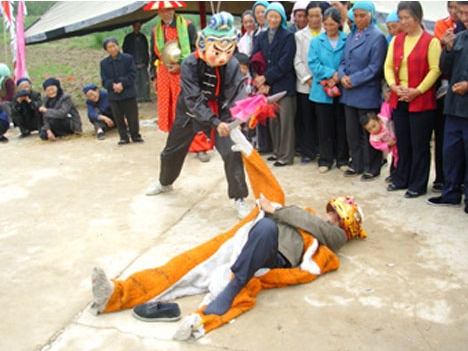



The Three Gorges of the Yellow River lie in Yongjing County in the southwest of central Gansu Province. They border on Qinghai Province to the west, and on the city of Lanzhou to the northeast. The Three Gorges of the Yellow River has gotten the name because the Yellow River flows through a 107-kilometer stretch which includes Bingling Gorge, Liujia Gorge and Yanguo Gorge. In the gorges, there are three branches flowing into the Yellow River, including Huangshui River, Tao River and Daxia River. Accordingly, the gorges are also called "Hehuang Area." Abundant resources of Nuo culture can be found in the gorges, specifically, in some villages beside Bingling Temple in the upper reaches of the Yellow River, such as Yangta Village, Wangtai Village, Hongquan Village and Sanyuan Village. In Yongjing County, Nuo dance is called "the dancing party in July." Nuo culture and art of local characteristics in Yongjing are composed of interesting Nuo dance, Nuo conventions, and Nuo masks. The cultures of Central Plains and ethnic minorities interact and mingle with each other, thus giving rise to Nuo dance which has been widely transmitted. As an embodiment of multiculturalism, Nuo dance has integrated cultures of northern and southern China, the past and the present. As a cultural complex, Nuo incorporates primitive religions, sacrificial ceremonies, folk conventions, music, dance, and the art of masks. During the past thousands of years, it has gradually fostered a complete cultural system. Nuo can be rated as the "living fossil" of theatric dance.

Also called "the dancing party in July," Nuo dance features a long list of plays, and a great variety of forms. In terms of the content, the plays break down into three categories, specifically, those involving music and dance, those of theatric performance, and those of vaudeville. The first category embraces singing, dancing, accompaniment of gongs and drums as the forms of performance. The representatives include Beheading Diaochan, and Fangsiniang. The second category comprises the spoken parts of the characters and simple singing tunes. If there is a war in the story, gongs, drums and cymbals will be played to boost the morale. Entailing long performance, the second category of plays still embodies the features of the earlier drama. The representatives include God Erlang Exorcizing Ghosts, Five Generals, Li Cunxiao Fighting the Tiger, and Five Passes. With funny masks, gags and clowns, the third category is humorous and cheerful. The representatives include Buddha Maitreya Dispelling Rain and The Peasant.